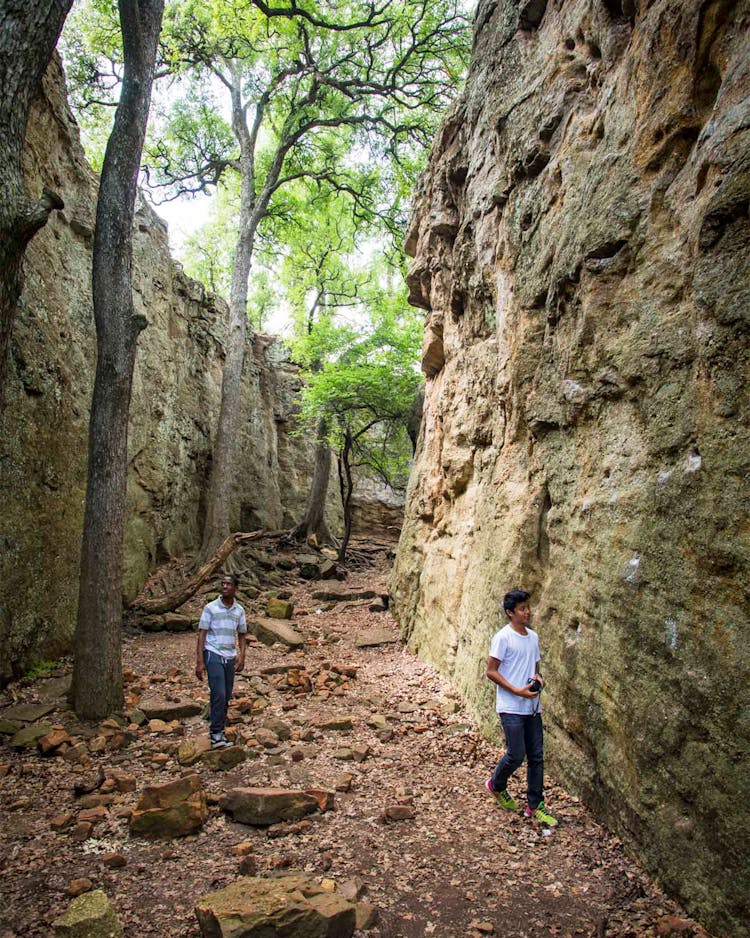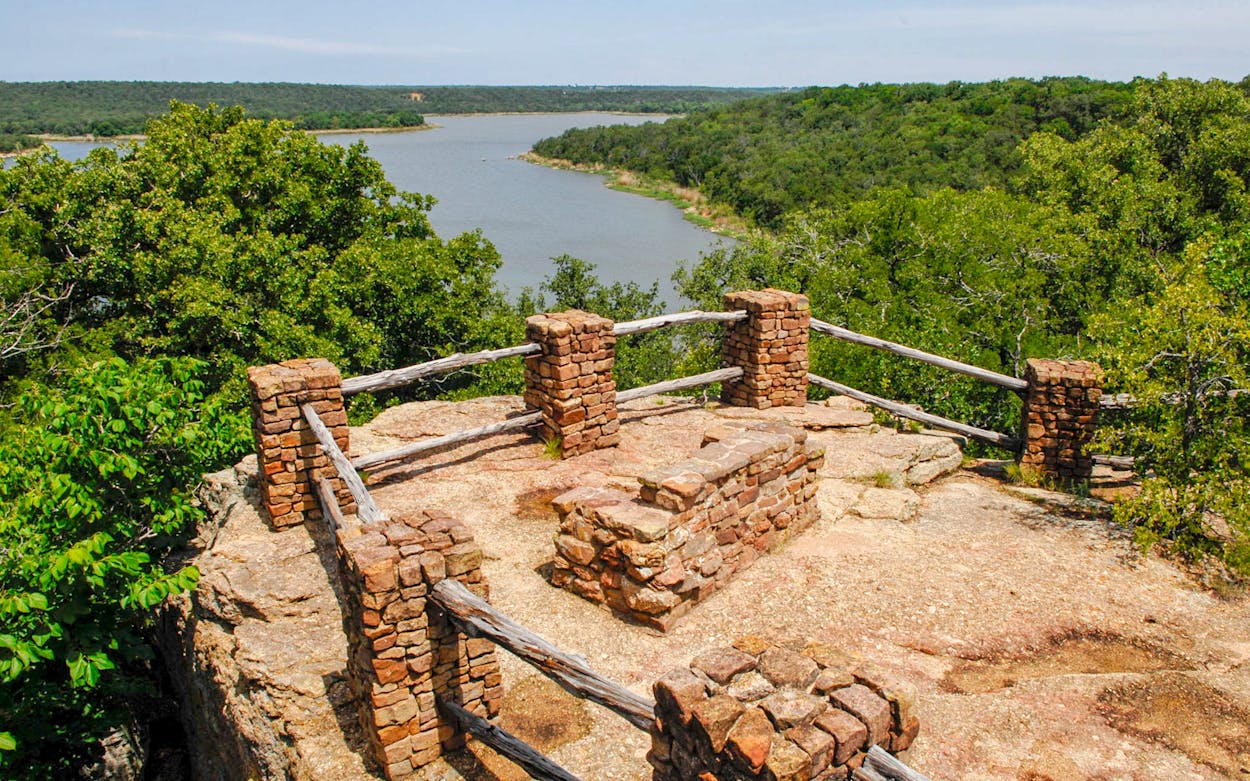Two limestone rock walls narrow to a tiny crevice near the Red Waterfront Trail at Lake Mineral Wells State Park and Trailway. Lichens and moss cover the rock face, and a few thorny bushes grow by the dark entrance. Shagbark hickories reach up to the skies and provide perches for musical canyon wrens. “You never know who’s going to make it through ‘the Squeeze,’ ” says David Owens, the assistant park supervisor, who’s leading our hike. Undeterred, my eleven-year-old daughter, Amelia, runs right in and races 75 feet to the other side in no time. “I’m done!” she shouts, her words bouncing off the rocks and cliffs surrounding us. “It was dark. Rocky. But you could see the light from the other side.”
The “Wild Walk” we’d signed up for at this 41-year-old state park, just east of the North Texas town of about 15,000, was a lot wilder, harder, and more breathtaking than I expected. We went “off trail,” finding our footing over unsteady rocks and massive limestone formations surrounded by forty-foot cliffs. This hike wends around one of the state’s most famous rock climbing and rappelling areas, Penitentiary Hollow. It’s the most popular area in the park and one of the only places on public land to go rock climbing in North Texas. We passed two groups of hipster-cool rock climbers during the day and saw one man hanging from a rock ledge. Amelia was impressed.
On this warm Saturday in February, Owens led our group of roughly thirty hikers for three hours to less-visited places in the park. We crawled under and over massive sandstone and limestone formations characteristic of the Western Cross Timbers ecoregion, which runs from north-central Texas up through Oklahoma.
Even though I wimped out on the Squeeze, I belly-crawled through a cave, jumped a small cliff, and hiked up carefully crafted stone steps much older than me, created by workers with the Civilian Conservation Corps and Works Progress Administration during the Great Depression.
More than 140,000 visitors come here each year to climb, hike, and camp. Owens and his fifteen colleagues must strike a balance between making room for them all and conserving the plants, animals, and geologic features that draw the visitors here in increasing numbers. We drove an hour west from our home in Fort Worth, passing small towns like Cool and Millsap. Even though I’ve been coming to Mineral Wells since I was a girl for tennis tournaments at the local country club—where my cousin and I liked to steal maraschino cherries from behind the bar—I never imagined something like Penitentiary Hollow existed. Nor did I know that the park is home to unusual species such as the Jack-in-the-pulpit. This green flowering plant isn’t even supposed to be here, Owens says. It grows primarily in the eastern United States. Same goes for the shagbark hickory tree; a botanist told Owens this park is the farthest west the tree grows.
We waited on the other side of the Squeeze for about an hour while other hikers in our group ventured into the rocks, some making it through and others turning around in defeat. Owens held up his phone and played a recording of the call of the canyon wren, another species that shouldn’t exist here but does, along with about 189 other kinds of birds found in the park. Their chirping and the crunch of leaves under our feet were the only sounds besides human voices and the huffing and puffing that hard hiking brings.
Owens warned us to watch out for copperheads, whose bites are so painful that, he cheerfully reported, “You kinda wish you were dead.” Suited up with gloves, kneepads, and hiking boots, the 23-year Texas Parks and Wildlife veteran knew his way around these rocks, the wildlife, and the eleven miles of designated trail throughout the park. This was one of the last hikes he’d lead until the fall, giving the ecosystem time to recover from all of the human footprints, which are likely to increase as Mineral Wells continues to boom in popularity.


The town has grown more in the last year than in the last thirty years combined, says Randy Nix, longtime Mineral Wells resident and part owner of many properties across town, including the newly renovated Crazy Water Hotel. The hotel, first opened in 1912, sits atop the site of the third mineral well dug here in 1881. And it’s how the hotel got its name, long before the Crazy Water Bottling Company sold its bottles in grocery stores across North Texas. Today Mineral Wells is capitalizing on its history, marking the entrance to downtown on U.S. 180 with a replica of the original 1933 “Welcome to Mineral Wells, Home of Crazy” sign. The well-known and historic Baker Hotel and Spa is also under renovation. Nix and his wife, Misty, have also launched several downtown businesses, including the Market at 76067 and Coffee & Cocktails at 76067.
Nix has gray hair, a short beard, and a permanent tan from spending his early years running a sprinkler business. He’s imposing but calm—and an expert on what makes his city special. “People come from all over Texas to visit this park,” he says. “It’s the topography here that sets us apart—it gives people a glimpse of the terrain in Palo Pinto County.” That county, with its cliffs, limestone, and Lake Palo Pinto, is home to the state park; Mineral Wells itself is split between Palo Pinto and Parker Counties.
The 3,282 acres of rolling, hilly, and cavernous terrain inside the park draw birdwatchers, campers, hikers, and rock climbers, while the twenty-mile stretch of trailway—which is the abandoned Weatherford, Mineral Wells and Northwestern Railway bed—brings equestrians, cyclists, walkers, and runners. There’s also the outdoor Lone Star Amphitheater, which visitors can rent for parties, plays, concerts, or maybe even poetry readings.
But Lake Mineral Wells is the park’s centerpiece. The 646-acre lake gives visitors a place to swim, fish, and go boating. Crappie and channel catfish are most popular with fishermen, says Owens, and there are no fishing licenses required in Texas state parks. The day we visited, the water was nearly motionless—like a watercolor set behind a dense covering of trees, thorny bushes, and massive rocks. The juxtaposition was nothing like any of the scenery in neighboring Fort Worth or Dallas. And rightly so: this is the only state park in Texas preserving the Western Cross Timbers region, according to Texas Parks and Wildlife.
The history of the city is indelibly intertwined with the history of the park. The railroad was chartered in 1889 after the discovery of the natural mineral water turned the tiny town into a wellness resort, attracting movie stars like Clark Gable. But, like so much of rural Texas, the community has drastically shrunk. First the Great Depression hurt resort and wellness tourism, and then the closure of the Fort Wolters Army base hit the local economy hard. “We’ve had no economic drivers for the last thirty years,” says Nix.
Today, the crazy growth of Mineral Wells has really put its state park on the map (literally and figuratively). Nix and his fellow developers hope that those who come seeking outdoor adventures will spend a little money downtown too. We met at the Crazy Water Hotel before the hike. My daughter got her new favorite stuffed animal at Toytopia, inside the hotel, and I got caffeinated and hydrated at the Crazy Coffee & Water Bar. The park gates were just a ten-minute drive away.
I’m 43, and I’d never been on a guided hike before. I’d never crawled under massive rocks, army-crawled on my belly in the mud, or watched my daughter be so filled with the delight found in the beauty of the natural world. “What do you think so far?” I asked Amelia halfway through the day. Her face gleamed and she smiled, fresh dirt covering her white tennis shoes. “Best. Day. Ever. It’s a ten out of ten.”
- More About:
- Parks & Recs
- Fishing
- Mineral Wells






